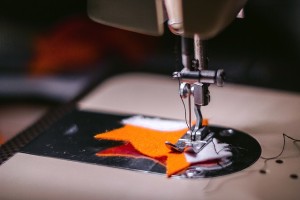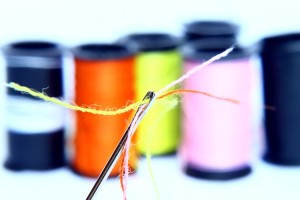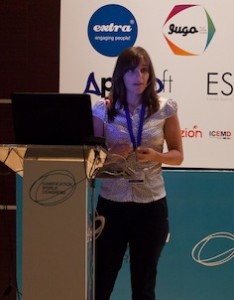In Part 1 of this series, we looked at defining smart fabrics. In Part 2, we looked at some design ideas. In Part 3 we will explore things that could go wrong with this technology, and offer up two possible futures for products using smartfabric tech.

(image via pixabay)
What are the Potential Drawbacks?
If we can access, visualize and interact with our digital lives with fabric, that brings a whole set of implications to design for (privacy, security, etc.) and the challenges of displaying and interacting with systems.
Imagine the possibilities. We will soon have clothing with:
- built in displays that can show you information, images and video you would normally see on a PC or smartphone screen.
- interaction with a system using certain gestures by touching your clothing.
- powerful, tiny sensors that monitor biological functions.
Pretty cool huh? These technologies are currently being developed, and they could open the door to some fantastic possibilities. They also have a darker side, with potential pitfalls.
The most obvious pitfall is to needlessly annoy the wearer with notifications or prompts to interact with their clothing. Over notifying can over stimulate our senses. If vibration or lighting/color changes are used to get our attention, this might be useful if it is used sparingly. If we get a lot of buzzes against our skin, or our clothing rapidly is changing color or displays or lights are blinking at us too much, smartfabrics products could make people sick.
Accidental interactions can cause unintended results. What if I can control my TV shows with my jeans by gesturing on the fabric, but every time I change positions in my chair, I change the channel? Controlling inputs, determining touch targets and gestures, as well as what to display, and how to notify people of events are difficult to implement well on something that is constantly touching your skin. Over-notify and people will want to destroy their clothing, tickle people and they will go crazy.
Target areas for inputs and outputs are important to consider in clothing design. Inputs and outputs need to be placed very carefully on the body. They could draw unwanted attention to a particular area of the wearer’s body. Even if they aren’t highlighting private parts, they may trigger body image issues if it highlights a perceived flaw in the wearer. It’s also easy to imagine accidental or even purposeful unwanted touching – someone could use the input as an excuse to touch you. If the design encourages interaction, it could be easy for someone to be compelled to touch you when they normally wouldn’t. Inadvertently encouraging unwanted touching in our designs could have very serious implications. Unwanted touching is assault.
On the other hand, in private, intimate environments, that sort of touching can be welcome and fun. Context, as always, is key to understanding interactions with things you can wear.
Beyond unwanted touching, pranksters or “griefers” might think it is funny to reach over and mess with your digital interaction by touching the smartfabric device while you wear it. This could cause your data to become corrupted or trigger unwanted events in a system. (What if you were trying to book a calendar event, your friend reaches over and taps their fingers on your shirtsleeve, and now you have a thousand calendar events?)
We live in public, and smartfabrics might accidentally display personal information that we wouldn’t want others to see. What if a private text or email is displayed to my coworkers in a meeting because it is displayed on my shirt? (You might not want that nude selfie your significant other texts you to be displayed on your suit jacket when you are in a job interview.) What if I work in HR and my boss sends sensitive salary information that is displayed to an entire department I am presenting to? It could also be inappropriate for your dress shirt to display your photostream in church, or if your sombre outfit suddenly played the Benny Hill theme during a funeral. Understanding context and appropriateness of what to display and when, and how much control over who might see it users have is vital to understand and take into account.
Security and privacy is a huge issue with smartfabric devices. Data that is gathered from a user wearing smartfabrics is deeply personal. Any information that is passed to other devices or systems absolutely must be secure. That data should never be intercepted and stolen, it is very personal and could be misused and cause great harm to the user. If data transmitted from clothing or other devices could be intercepted by a 3rd party, that could be very embarrassing and potentially damaging if it is used against them. Also, if servers or cloud-based storage facilities are compromised and smartfabric generated user data is stolen, that could be catastrophic to the people whose data has been collected. The inevitable public backlash could be severe enough to destroy a company. Furthermore, data privacy laws could be broken and an organization could be faced with fines, lawsuits and the resulting bad publicity. Everyone loses if the data generated and used by these devices isn’t kept private and secure.
Private information should not be displayed publicly on my smartfabric device unless I want it to be displayed that way. I need to control what is shown, and when with speed and ease. Other people should not see my current status of what is going on with me and my body unless I want them to.
Smartfabric devices need to have their capabilities completely under the control of the wearer. When a feature isn’t appropriate in a particular context, or if something odd happens, the wearer need to be able to turn it off or mute it. Even active smartfabrics that change their form depending on outside triggers require user control to be able to turn it off.
Under controlled conditions (such as the development lab) you may never see irritating behavior, but in the real world strange things can happen. If your dress changes color depending on light and you are at a dance club, the lighting could cause the dress to rapidly change color. That requires a lot of energy if it happens over and over, so the power source could overheat and cause physical trauma (ie. burning) to the wearer. At best, it might wear your battery down prematurely.
Compatibility with other devices and services will also be difficult to address. What if my smartfabric jeans will only work with Android devices, and I only use Apple devices? What if the clothing that looks good on me and fits my budget is incompatible with my file hosting services I use and depend on? What happens if the smartfabric device manufacturer changes alliances, and my favorite suit company now only supports a platform I hate using?
Reliability is another issue that is difficult with clothing because we have to clean it constantly. How do we create hardware that can survive different weather, food and drink spills, sweat and other bodily fluids, and constant washing and drying? Clothing takes an absolute beating, and we subject it to extremes when we wear it, and especially when we clean it. This is an incredibly difficult environment for electronics to survive in, let alone work reliably in.
Two Possible Futures
The Scary Future
If we design smartfabric experiences poorly, we will distract people from their real world experiences, causing them to live diminished experiences when they wear these products. Instead of using technology to enhance their lives, we could burden them even more than our always connected experiences do already. Also, having more devices reading more and more sensitive and private information creates the potential to track people and make decisions about them based on their movements and biological data. This has incredibly serious, far-reaching implications. If people or organizations use this technology to reward or punish people due to the data that is collected, we could literally have a dystopian future on our hands.
If we aren’t careful, we might just create smartfabric products that are expensive, unreliable, irritating and in some cases, downright dangerous. That will be the kiss of death for the technology. If the solutions aren’t designed with empathy for real people, using them in the real world, not to mention our user’s needs, bodies and state of mind, they will quickly be relegated to the dustbin of history. The good that we could do with this technology would be lost because we did a terrible job with the user experience when we introduced our products to market.
The Awesome Future
Back when I wrote programs to help people on software teams be more productive, we used to joke that we were giving them super powers. They could now get visibility and control within systems that was formerly hidden from them, and use that information to make better decisions, or to diagnose and solve difficult problems. Similarly, even though we have many senses and powerful observation skills, there is a lot about ourselves and our environments that we can’t see. Sometimes this information can be incredibly important to get insight into.
I was delighted when Shannon Hoover (MakeFashion) suggested a similar superpower design theme with smartfabrics. Shannon goes beyond the concept of visibility and control, and he believes smartfabrics will eventually provide us with different superpowers by extending our senses, or replacing those that are injured or defective. Shannon says smartfabrics can help provide “X-Ray vision” by reading and presenting certain kinds of important data that are invisible to us. Just like a radio interprets radio waves and brings sound into a living room, smartfabrics have the potential to show us our current location and alert us where to move if we are travelling and get off track.
There are also applications to help provide us more strength and stability, and while we don’t all have access to a SciFi robotic exoskeleton (at least not yet), they are being developed for commercial and health related applications. Shannon goes further pointing out “spidey sense” activities to sense hidden danger, or important events. If the smartfabric is alerted to something that is important for you to know, it can get your attention to warn you immediately. Smartfabrics can use haptic feedback by interacting with your sense of touch in various ways to get your attention quickly.
Smartfabrics that sense danger and warn the wearer can be incredibly powerful. In particular, if our own senses are impaired due to illness, clothing that can warn us when our bodies are unable to can be life changing. Orpyx have created a vest that notifies people who can’t feel their extremities properly. Diabetic neuropathy sufferers can be warned of too much pressure in their feet by using sensors to vibrate against the wearer’s back to warn them. If your feet are getting injured, but you don’t feel pain, you can cause irreparable damage. Augmenting your body with another system to help prevent damage is an amazing feature to improve the life of people with illness and physical conditions. This also has enormous implications for safety gear and clothing for workers.
Once the wearer gets used to the alternative, haptic feedback, it feels as natural as the normal pain signals your body generates that you no longer feel from damaged areas. The technical term for this is “neuroplasticity”. Smartfabrics have the potential to use this as an “extra sense” to seamlessly interact with us in our environments. Shannon sees a future of products that can provide extra senses even for healthy users, to alert them or aid them as they perform tasks in the world so they are safer, happier and more productive.
Smartfabrics also have more whimsical applications that are also important. Imagine that you are at a holiday party in your new dress, shoes and accessories to match. You’re feeling good about yourself until you spot your nemesis from accounting. “That #$%#! She is wearing the same outfit! Disaster!”
What do you do?
Smartfabrics to the rescue! You quickly dart out to the powder room, and with a quick, discrete gesture, you change the color of your dress. Crisis averted! This might seem silly compared to important medical or other applications, but this kind of technology would be incredibly useful for our quality of life.
Conclusion
Enhancing our bodies and our life activities with smartfabrics has the potential to enhance our senses, extend our physical capabilities and greatly inform our knowledge and insight. The choice for what future we want to bring to our users is in our hands. Do we want to enhance the lives of people who will use our products, or do we want to needlessly distract them away from what they should be experiencing?
Once smartfabric technology is reliable and inexpensive enough, we designers have some important work to do and not much time to do it in. Therefore, we need to choose what future we would like our customers to have even before we start designing.


